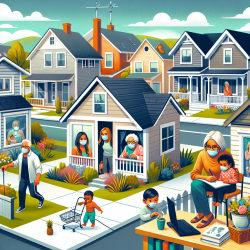Understanding Neighborhood Dynamics During the Pandemic
The COVID-19 pandemic has significantly altered the way we perceive and engage with our neighborhoods, especially for older adults who are aging in place. The research article "Aging in Place During a Pandemic: Neighborhood Engagement and Environments Since the COVID-19 Pandemic Onset" provides valuable insights into these changes. This blog post will explore how practitioners can leverage these findings to enhance their skills and encourage further research.
Key Findings from the Research
The study identified four main themes regarding neighborhood changes during the pandemic:
- Altered Social Interactions: The pandemic has led to both diminished and enhanced social interactions. While some older adults experienced isolation, others found new ways to connect, such as through outdoor activities and online platforms.
- Support Levels: The pandemic has affected the levels of support within communities. Some neighborhoods became more cohesive, providing increased support, while others experienced a decline in community support.
- Community Changes: Changes in community activity levels and adherence to public health guidelines have been observed. These changes have impacted the social fabric of neighborhoods.
- No Observed Changes: For some, the pandemic did not significantly alter neighborhood dynamics, highlighting the diversity of experiences.
Implications for Practitioners
Practitioners working with older adults can use these findings to improve their practice by:
- Enhancing Social Connectivity: Encourage the use of technology to maintain social connections. Online platforms can be a valuable tool for older adults to stay connected with their communities.
- Promoting Outdoor Activities: Encourage older adults to engage in outdoor activities, which can enhance physical and mental well-being.
- Building Community Support: Facilitate community-building activities that promote mutual aid and support among neighbors.
Encouraging Further Research
The study highlights the need for further research into the long-term effects of the pandemic on neighborhood dynamics and aging in place. Practitioners are encouraged to explore these areas to better understand and support older adults in their communities.
To read the original research paper, please follow this link: Aging in Place During a Pandemic: Neighborhood Engagement and Environments Since the COVID-19 Pandemic Onset.










